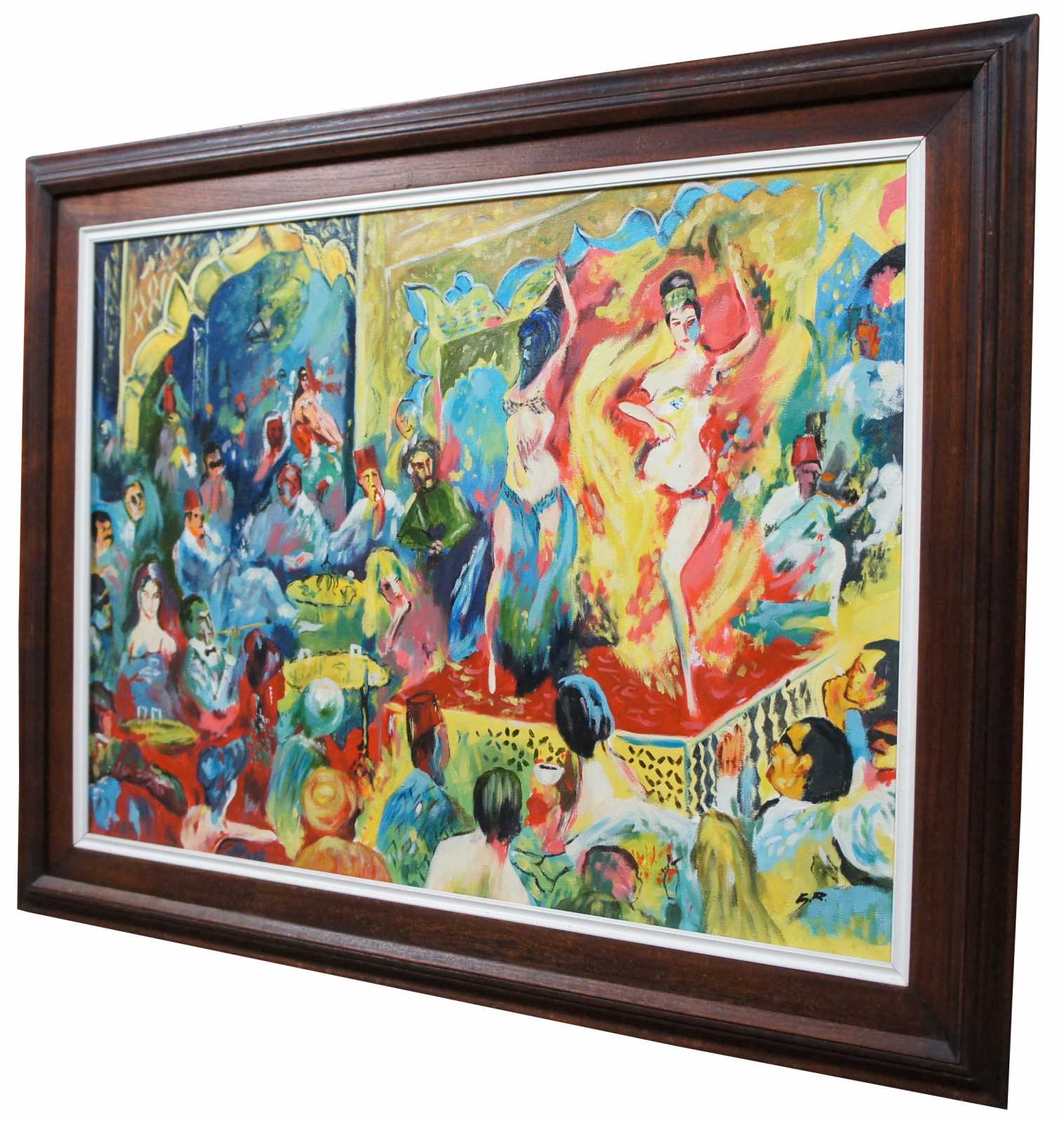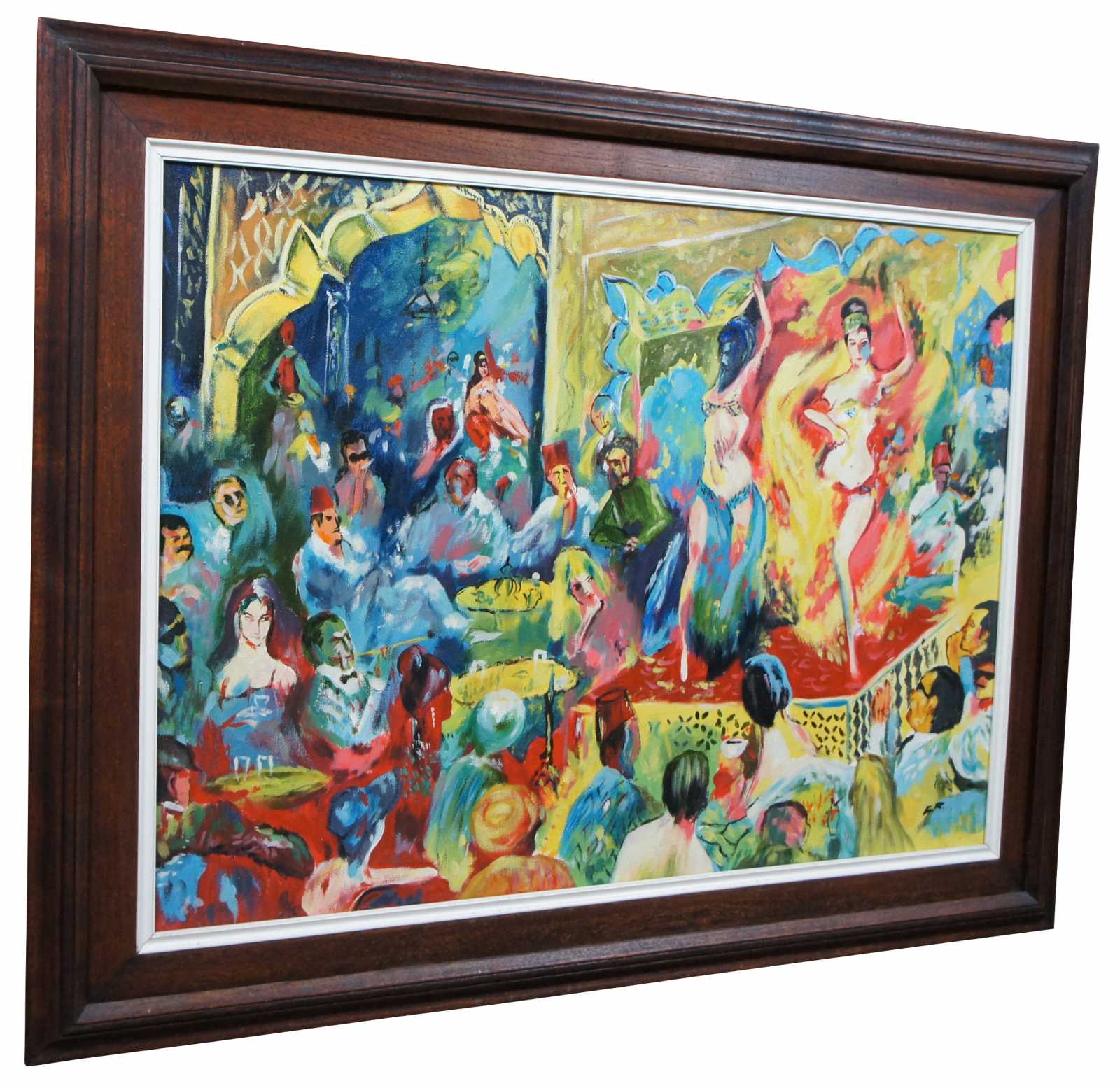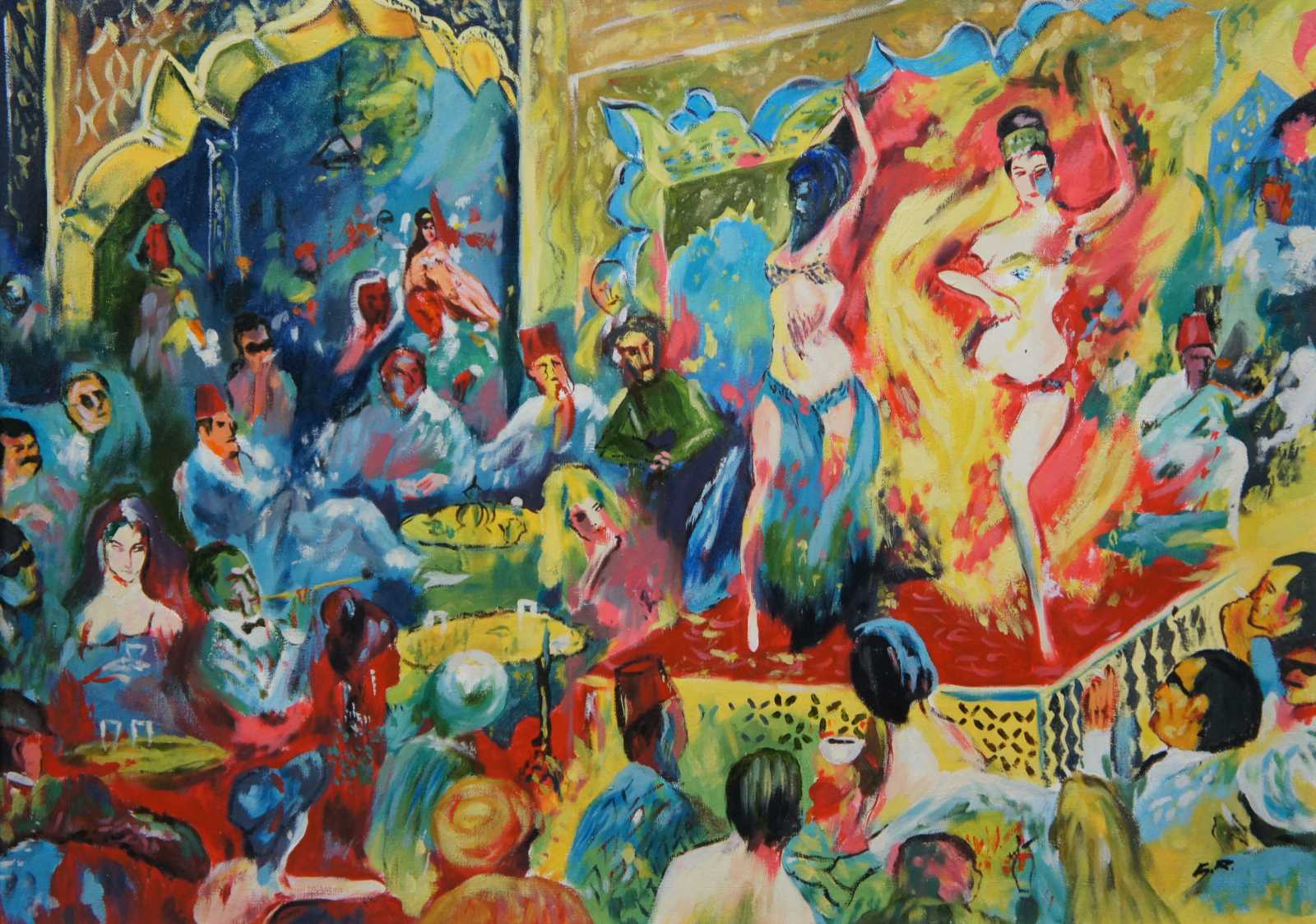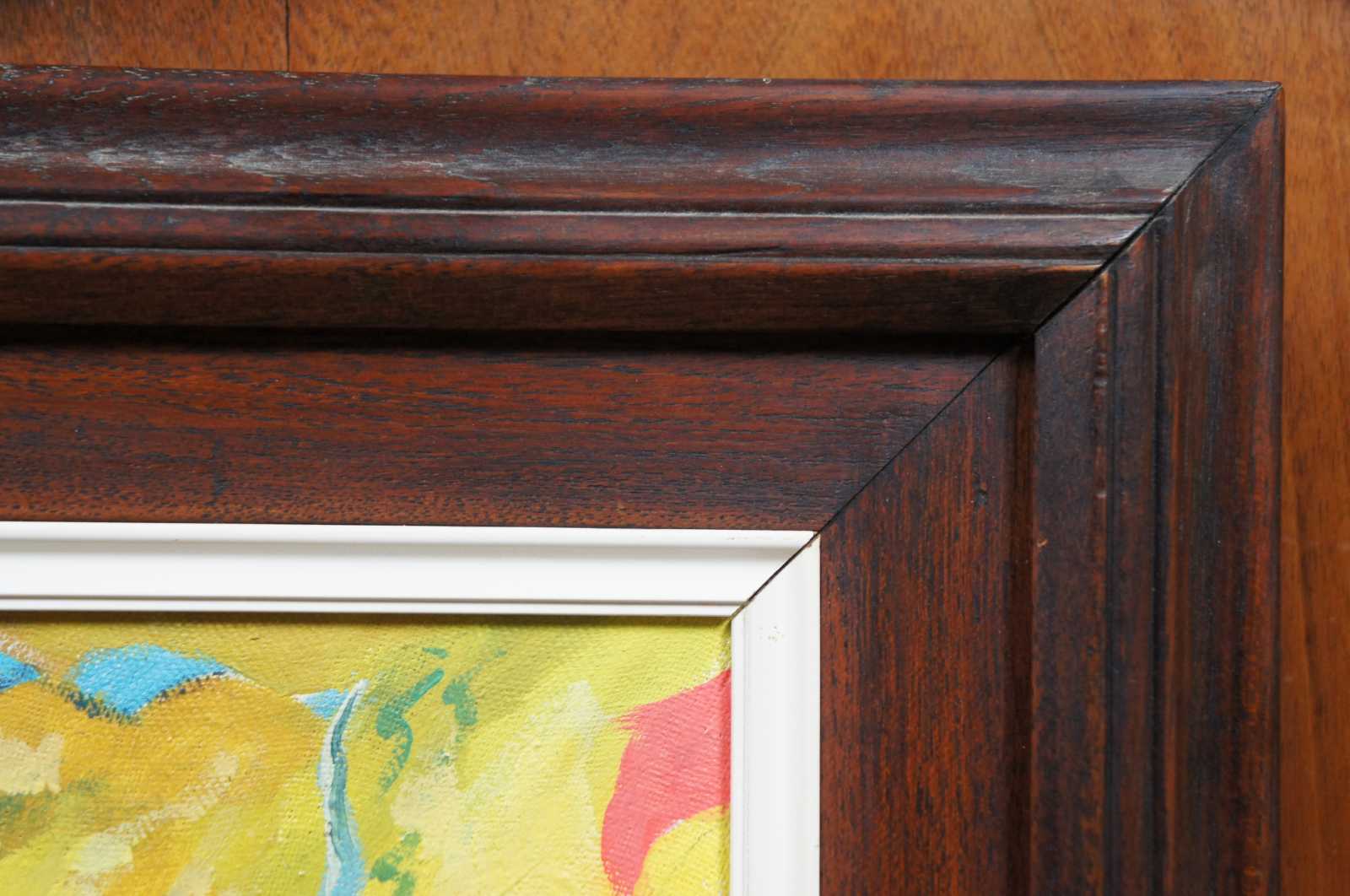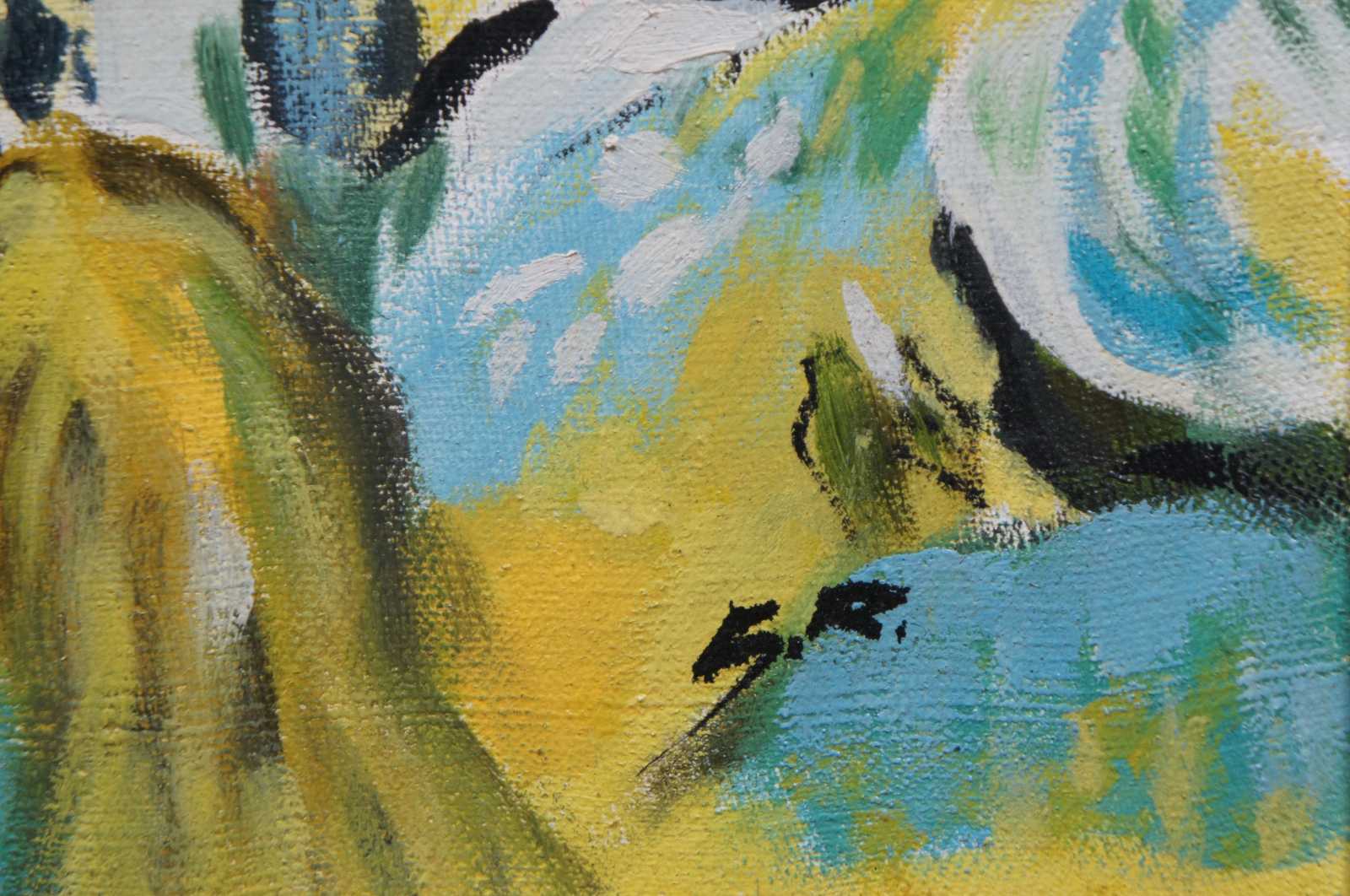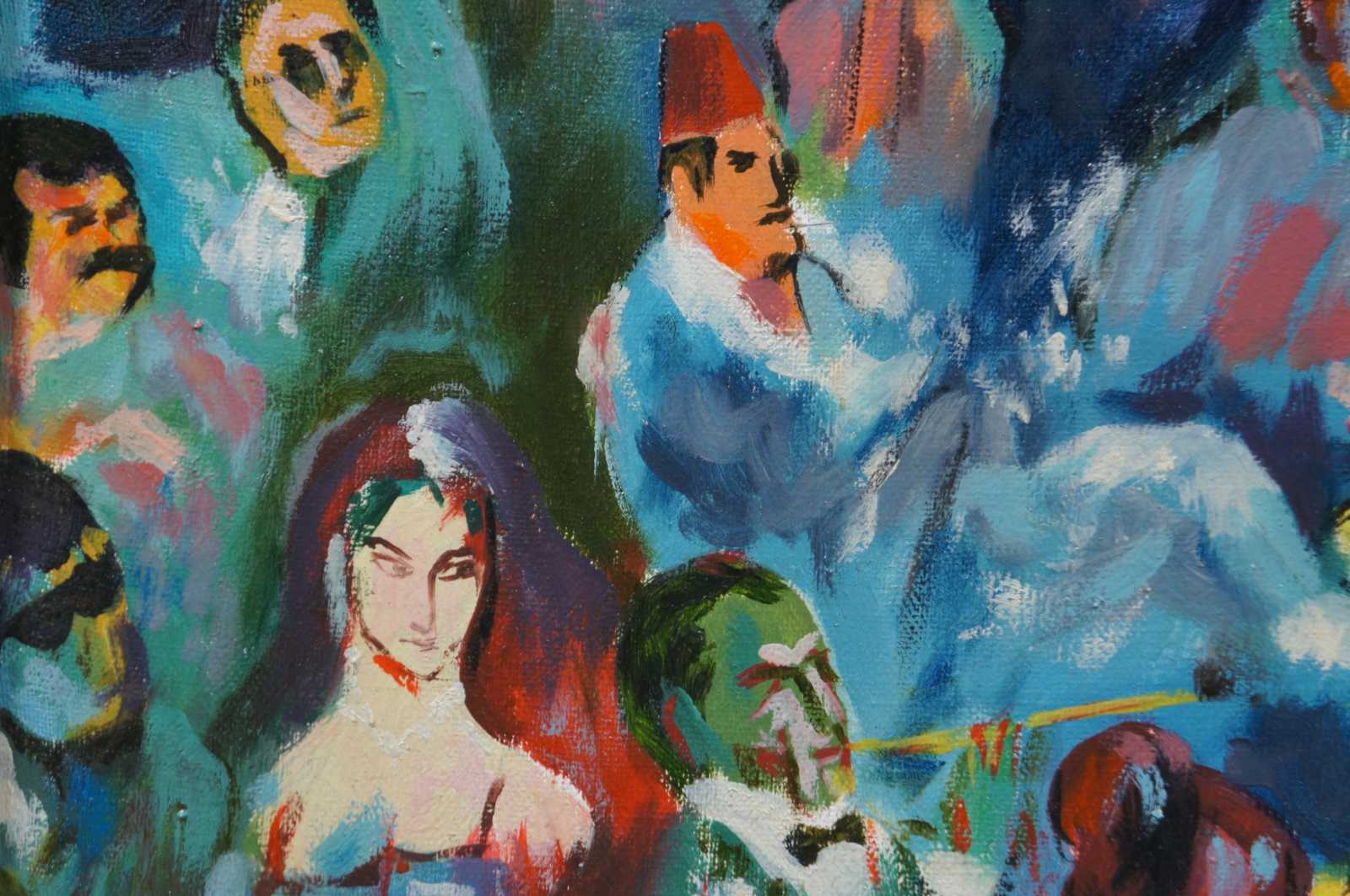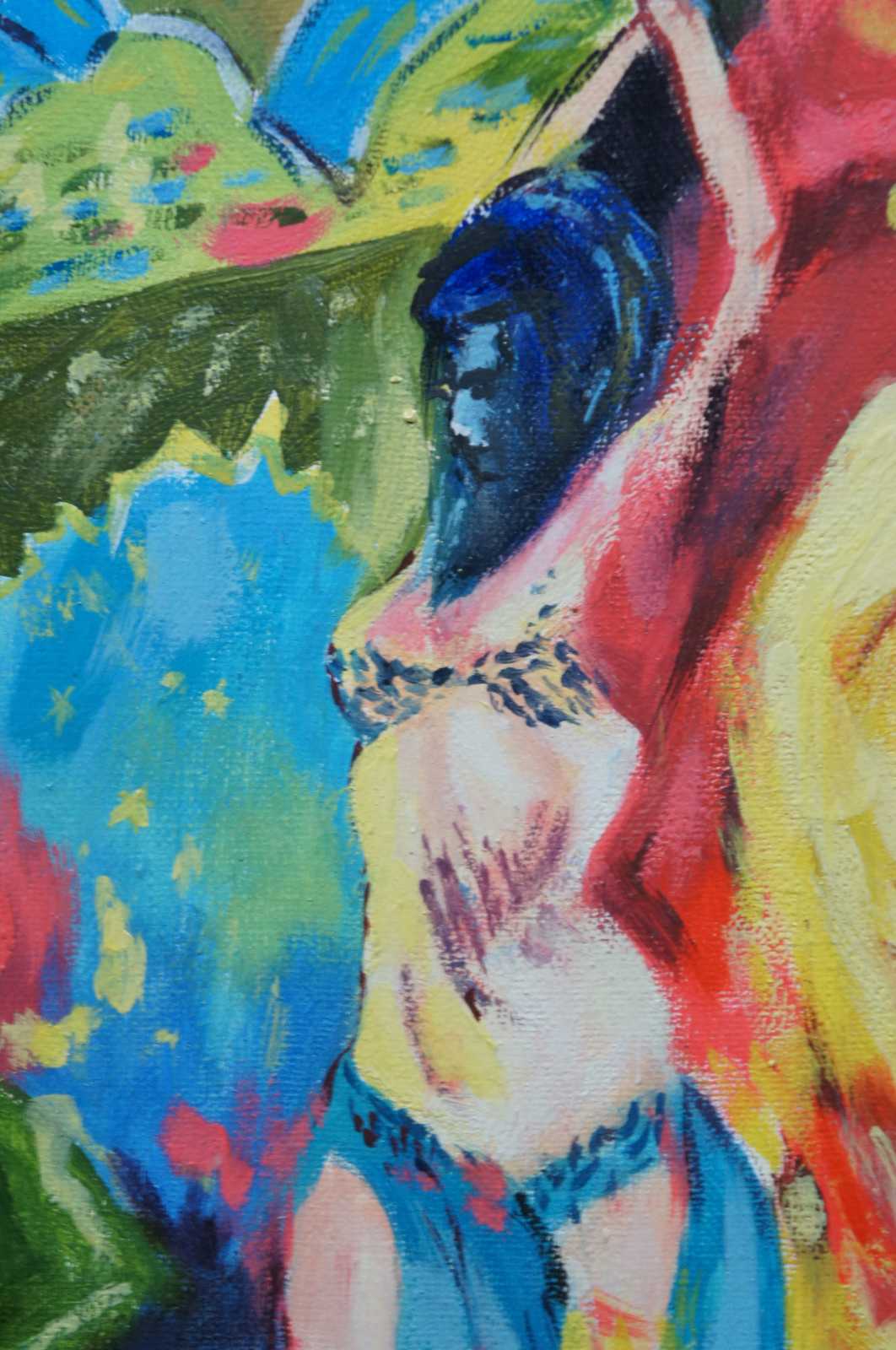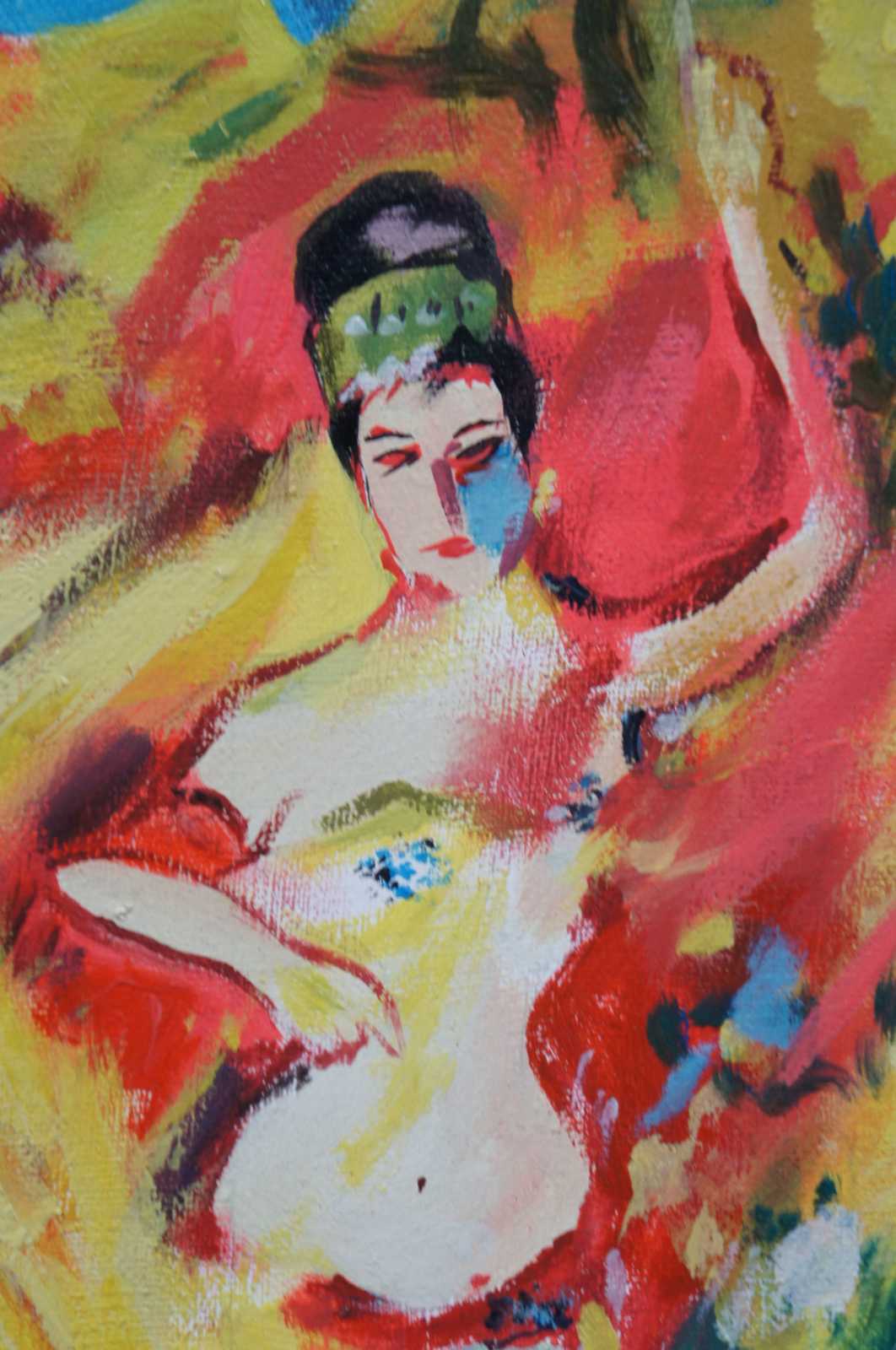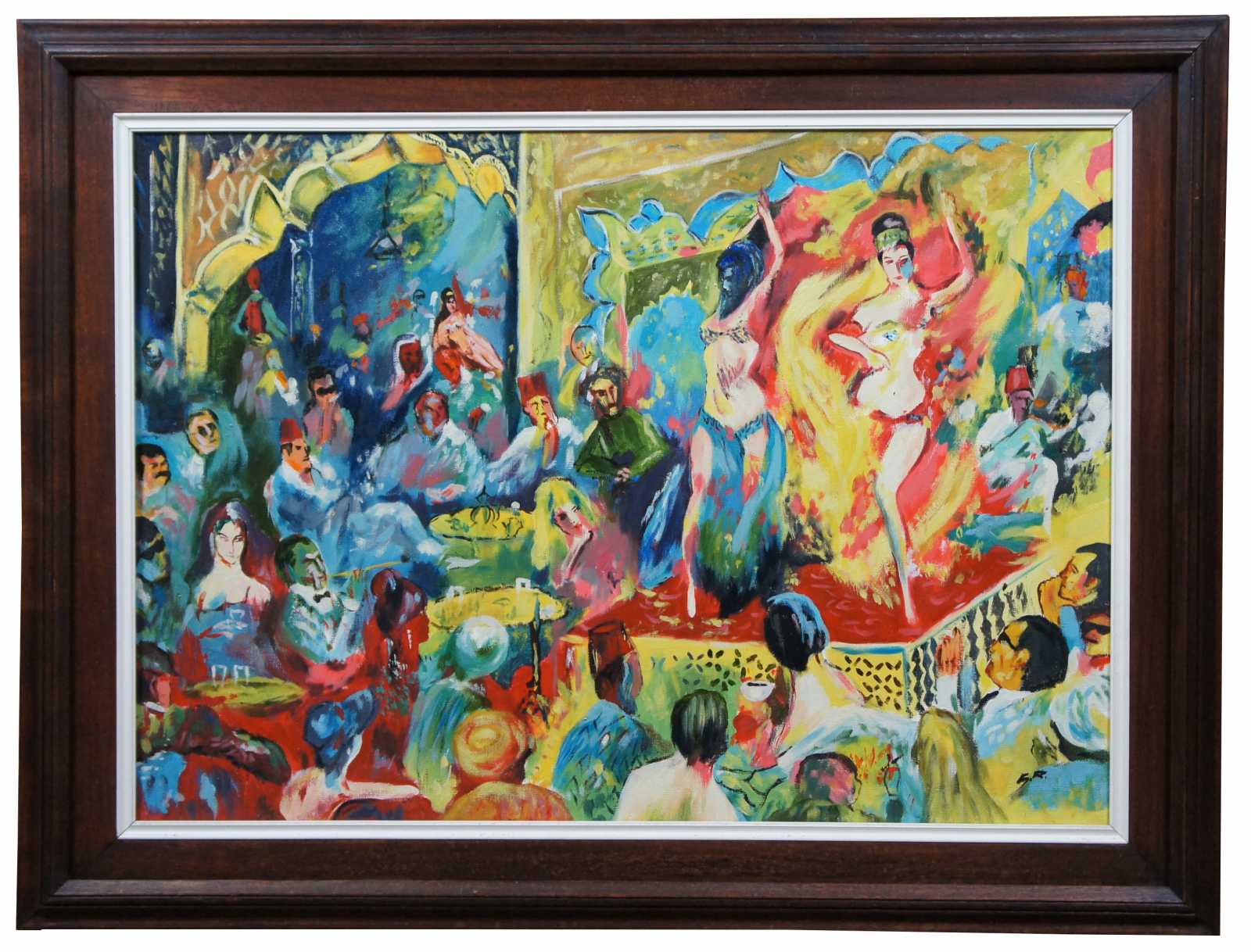
Original Oil Painting on Canvas Belly Dance Scene Expressionist Middle Eastern 34"
Sold
Shipping:
Free Shipping Included
Delivery:
Estimated 2-15 Business Days
Payments:
Credit Card, Check, Cash, PayPal, Apple Pay, Venmo
Returns:
30 Days 100% Money Back Guarantee, Buyer Pays Return Shipping
Description
Vintage colorful oil painting showing an expressionist Middle Eastern bar or restaurant scene with performing belly dancers; signed SR in lower corner.
A History of Belly Dance
There are many mysteries around the subjects of the origin of belly dance. Until today the theories are actively debated among dance experts.
There is an interesting legend describing emergence of belly dance as an accident. Allegedly, once a bee has flown under the flowing clothes of a street dancer. The dancer, without interrupting the performance, tried to get rid of a tiresome bee by shaking her torso. The girl was very gracefully therefore the casual audience has taken it for a special type of dance and has come to the real delight. The clever dancer has noticed the success and attention and continued to move in a new unprecedented way, showing beautiful lines of a body and hands.
Of course, it is only a legend. Roots of an oriental dance disappear deeply, and even now it is still impossible to define precisely the exact place of birth of belly dance.
Other version states that belly dance has descended from a religious dance which bore sacral sense, praised feminine origin, goddesses of fertility and women in general. In the society of that time Belly dance symbolized what was considered as divine mission of each woman: process of conception of the child, incubation and childbirth. As early as 1000 B.C., temple engravings depicting dancers have been found in Mesopotamia, Egypt, and Greece. They connect the emergence of belly dance with the ceremonies worshiping of the Egyptian Goddess Isis, the Greek Aphrodite, Mesopotamian Ishtar, all of whom are personifying an image of Great Mother Goddess. Until today some Bedouin tribes perform the ceremonial dance – women surround the woman in labor far from male eyes, and dance driving away all evil spirits. They make movements similar to the movements of labor so that spirits can’t distinguish which one of the women gives birth, and can’t steal the soul of the newborn.
Gradually belly dance began to lose its sacral value and became secular. Christianity and Islam forced out paganism, and dance lost its element of spirituality. Dancers were hired for entertainment on social events, women danced on family holidays on female half of the house, or alone personally for the husband, being performed without a special cause. It became known in all countries of the East, including India, Ceylon, Japan, Afghanistan, Africa (Egypt, Ethiopia, Tanzania, Botswana, Nigeria), Europe (Spain, Italy), in Far East territories.
The very important role in spreading belly dance was played by Gypsies. They were a connecting link between various cultures. Wandering all over the world, they left their cultural marks and absorbed the color of the culture of the country through which their path went.
Belly dancing image began to gradually change under the influence of Hollywood. Dancers who wore lots of long clothes, and emphasized hips with a scarf became more glamorous. The new look of sparkly suit and a naked stomach, has appeared originally at cinema. Dancers of Egypt began to copy this image therefore the movements became clearer. In 1926 the Lebanese actress and dancer Badia Masabni has opened night club “Opera Casino” in Cairo just like the European cabarets of that time. Since then a concept of prepared choreography became more common opposed to the improvisational dance as it was earlier. Few of Badia Masabni`s students such as Samia Gamal (who was first to perform on heels) and Takhiya Karioka (who was first to add latin rithms) became legendary stars of orient. Badiya’s casino quickly became popular: Arab members of high society and guests from around the world visited the place with pleasure. Clubs similar to Opera Casino began to open in other cities. Overall, Badia can easily be called the grandmother of modern day belly dance. Her club established belly dance as a respected art form.
In the 50th of the 20th century Cairo night clubs have lit great dancers of orient such as Zukher Zaki, Aza Zarif, Nagwa Fuad, Nadiya Hamdi, Fifi Abdou and Raqia Hassan. But Islamic laws became strict and belly dance was banned on religious grounds. However, it became clear that belly dance was one of the biggest forces attracting international tourism to Egypt. More importantly, bellydance was an integral part of Egyptian culture. Soon the ban was lifted, but there were several restrictions: the stomach has to be covered; floor work is prohibited; over-sexuality is banned. Only Bahrain and Libya preserved more liberal views on belly dance and treated it with respect. In Turkey belly dance was a popular style of cabaret, suits of dancers were more open and seductive than in other countries. Dancers who became famous at that time had the most affect on the style of belly dance and manners of movement.
The huge contribution to belly dance was done by the founder of his own troupe Mahmoud Reda. In the sixties the 20th century he has successfully transferred folk dance (including the well-known Alexandria dance) to the stage. Other choreographers had followed his example and started rapidly developing in same direction. His troupe left a whole legacy of great teachers and dancers including such stars as Rakkia Hassan and Farida Fahmy.
Coming to America
The term “belly dancing” is often credited to Sol Bloom, who brought oriental dancers to 1893 Chicago World’s Fair. At the time of high moral standards when even a naked ankle considered to be indecent, Sol Bloom managed to shock conservative public with the perverted presentation of oriental dance, which he called belly dance. Puritan society of North America was outraged by “immodesty” of the dancer and had belly dance associated with striptease. Even though the newly-introduced dance cought a lot of attention it was far from being authentic, but more of a novelty for the crowd.
Ruth St.Denis, who was immersed in Oriental philosophies, became one of the first belly dancers of the American origin. She has transferred belly dance to the field of high art, perceiving it as the folk scenic dance allowing to get into the spiritual sphere of east culture. First of all Ruth was an actress, she perceived technique of belly dance in her own way. She adapted ballet norms, managed to present belly dance in a respectable form and achieved respect of public for this art: earlier it was perceived by ordinary Europeans only in an erotic context. Now the daughter of the American millionaire Gertrude Vanderbilt took belly dance lessons from Ruth and sometimes danced for the guests.
Ruth St. Denis
When Hollywood stepped in to undertake the middle-eastern wonder, and has done a great job promoting belly dance in USA: television shows (including educational) involved more and more people.
Belly dance has now become a part of international pop culture.
And most importantly: belly dance has made its round to the west and “has returned” to its native lands, having enriched local traditions. Middle-Eastern countries such as Egypt, Turkey, Lebanon, Morocco, Syria, Jordan, U.A.I., Iran, Tunis remain as capitals for belly dance lovers and stimulate dancers to achieve the highest levels of professionalism.
Condition
Very Good - See pictures
Dimensions
34” x 0.75” x 26” / Sans Frame - 27.75” x 19.75” (Width x Depth x Height)
